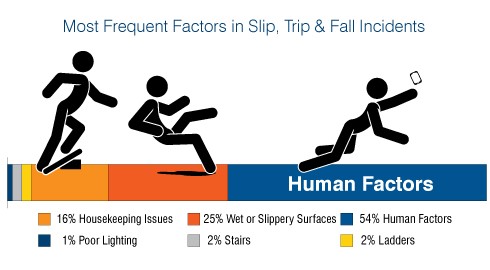Avoiding Slips, Trips, and Falls on and around Campus

Slip
A “slip” occurs when there is not enough traction between a walking surface and a shoe, often resulting in a loss of balance and potential injury.
Trip
A “trip” occurs when a person unexpectedly comes in contact with an object at foot-level, which is blocking their way, causing them to be thrown off balance. Trips often cause a person to fall forward, whereas a slip often causes a person to fall backward.
Fall
A “fall” occurs when a person is greatly off balance. There are a variety of scenarios that can cause a fall, such as slipping and tripping on uneven walking surfaces, loose carpet, electrical cords, clutter, even walking on loose materials such as gravel.
Preventing Injuries
In order to prevent injuries, our campus community is encouraged to report potentially hazardous areas where there is potential for a slip, trip, or fall to occur. Such areas include: wet or slippery surfaces, areas that are poorly lit, and areas that change in elevation quickly.
If a hazard is encountered, and unavoidable, take the following precautions: when crossing wet surfaces take slow and small steps and use hand rails when available; when passing through a dim or poorly lit area, move slowly and focus on your path of travel; when walking through campus be mindful of stairs, bumps, potholes, sidewalk cracks, and rugs that may cause a person to potentially trip.
Walking on Ice and Snow can be challenging. Snow and icy conditions accounts for many slips and falls during inclement weather. There are ways to stay injury free and ensure safety by noting the following safety tips:
- Giving yourself plenty of time to walk slowly using a penguin like gait in snow and ice. Spreading your feet out slightly while walking on ice increases your center of gravity.
- Leave your living quarters wearing proper footwear. A heavy treaded shoe with a flat bottom works best to grip the snow and ice and prevent slipping. (In addition wear closed toe shoes to prevent foot injury.)
- Take time to be alert while walking on ice and snow. And always keep an eye out for black ice. Black ice can be deceiving as it is common to mistake it for a wet surface.
- Make use of handrails on stairs, outdoor walkways, and vehicles.
- Remove snow or mud from your shoes before entering any building. And enter buildings cautiously. Your shoes may be wet and can cause you (or others) to slip or fall.
- Know your limitations. Carrying large packages or other items that limit vision can lead to slips and trips.
Visit the National Safety Council for more information about winter safety.
Visit the University Safety and Risk Management website for more information about reporting hazards on campus. Thank you, for helping us keep our campus safe!
Content information referenced from University of Wisconsin.
Photo with information/statistics from SafeStart.

